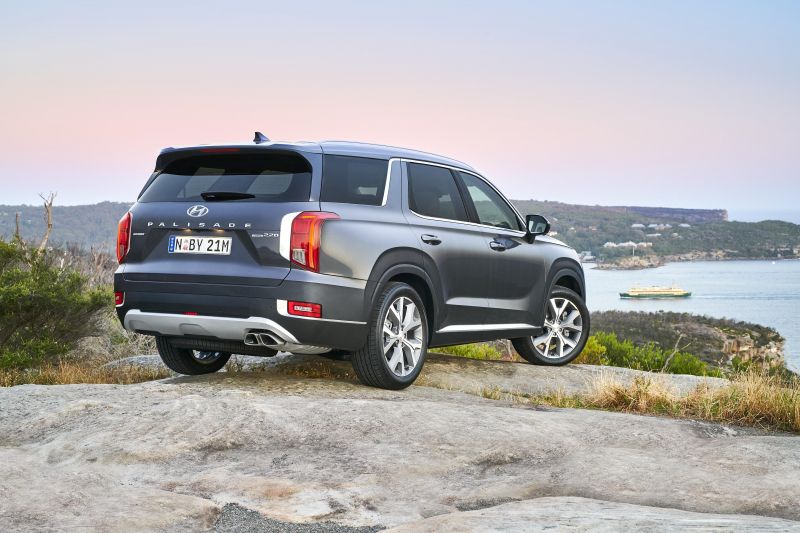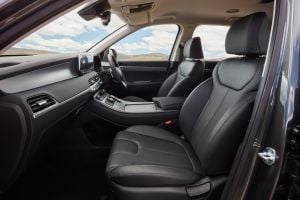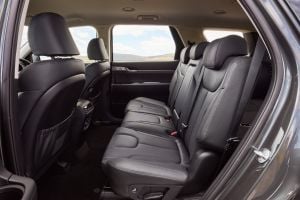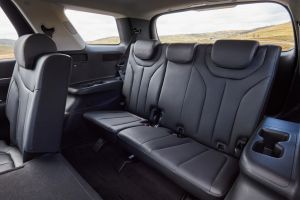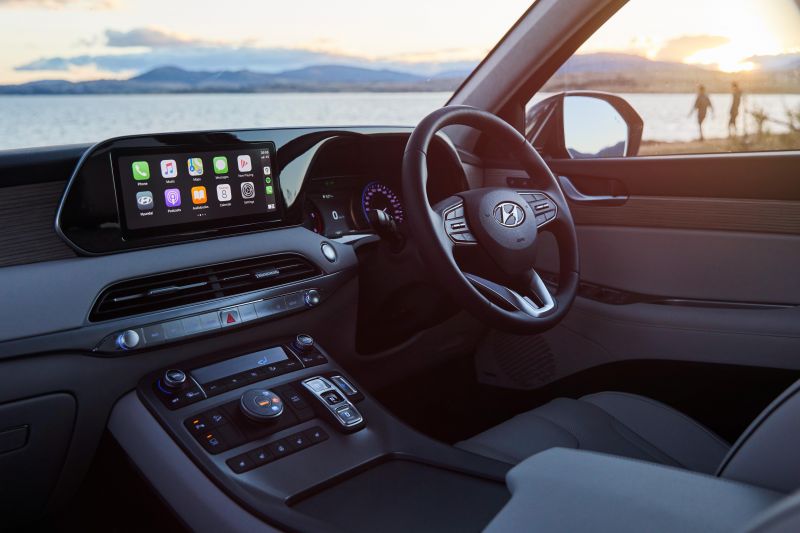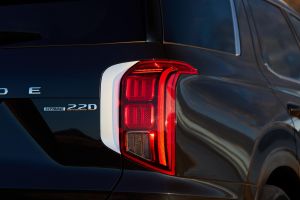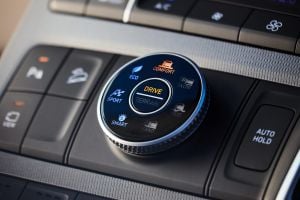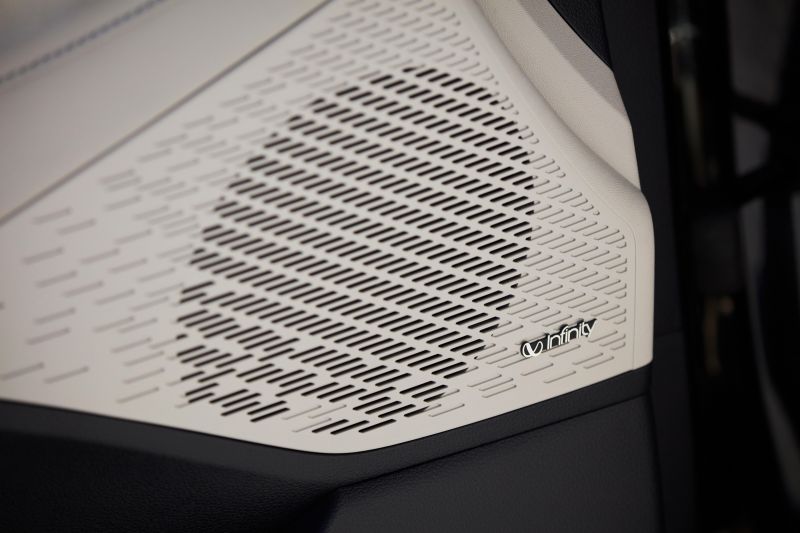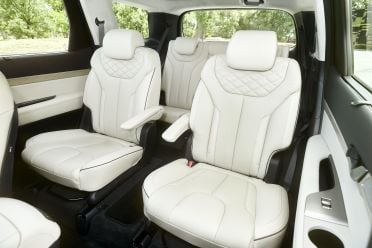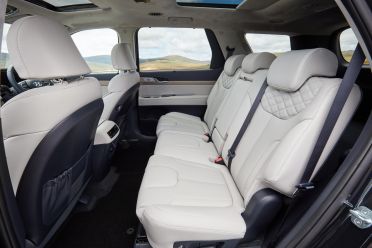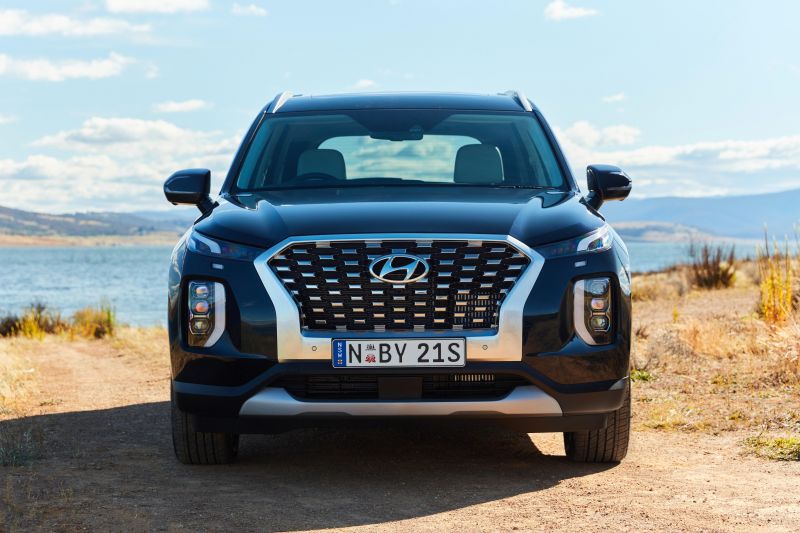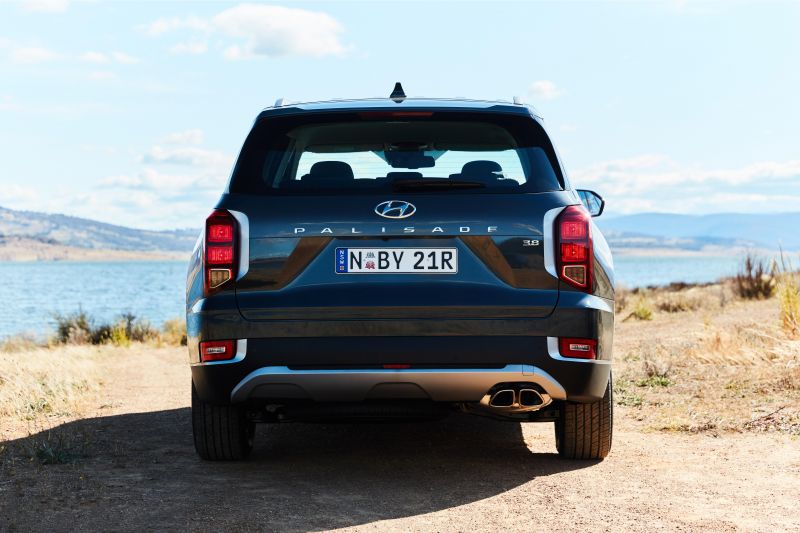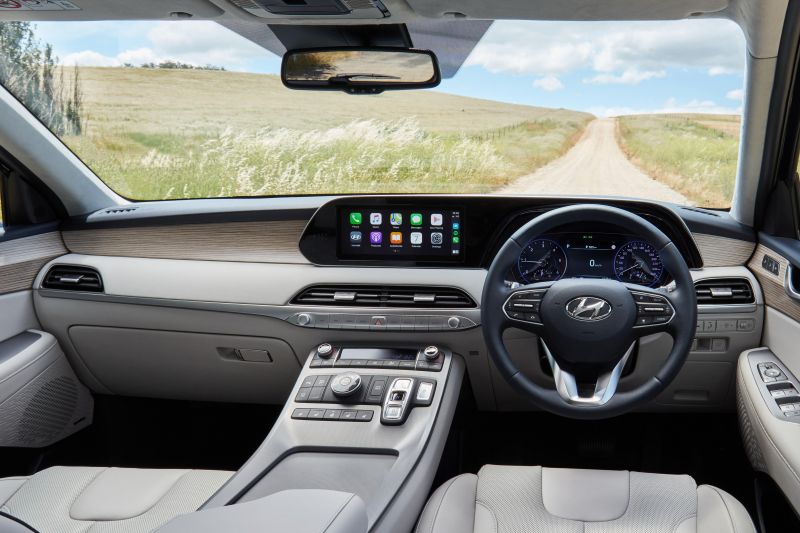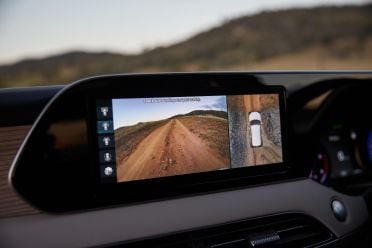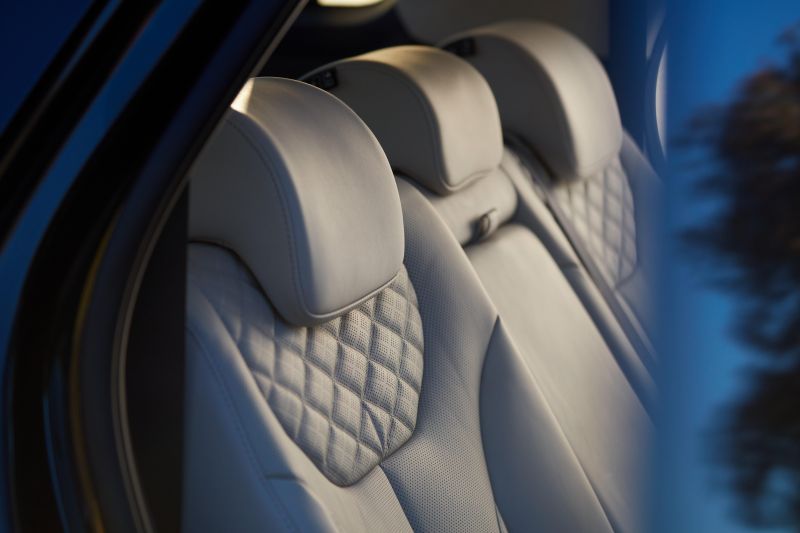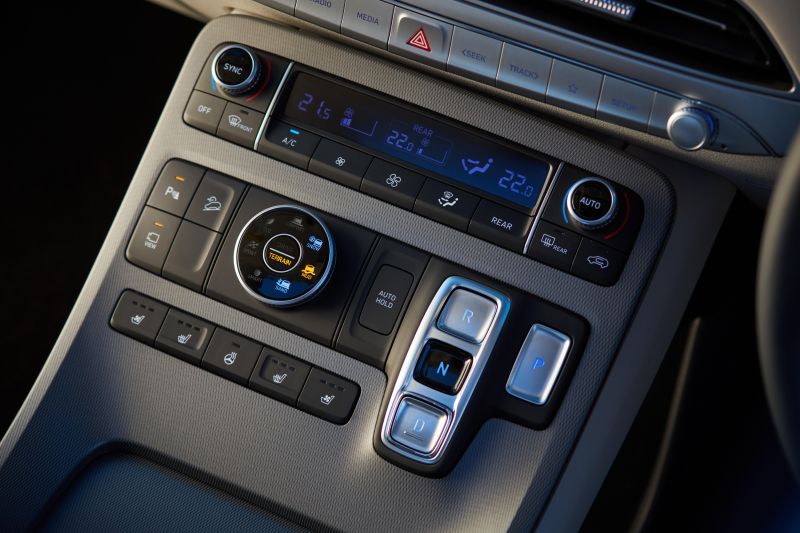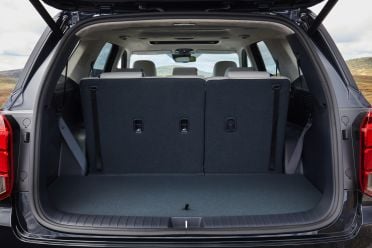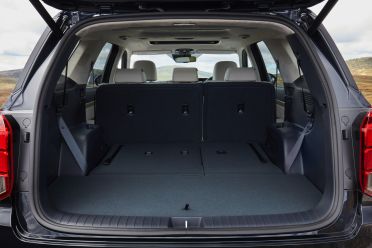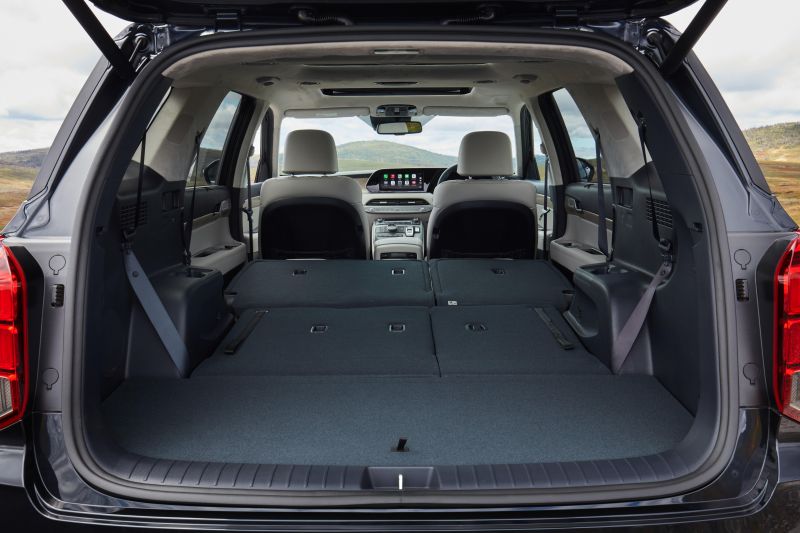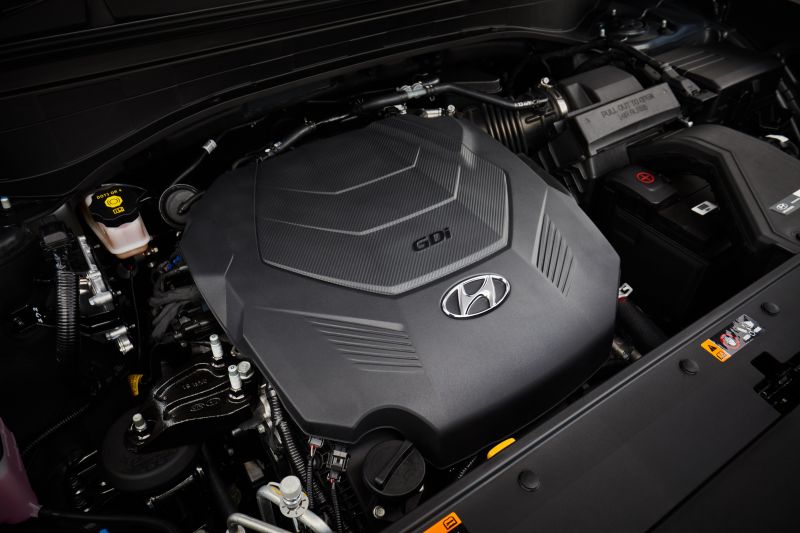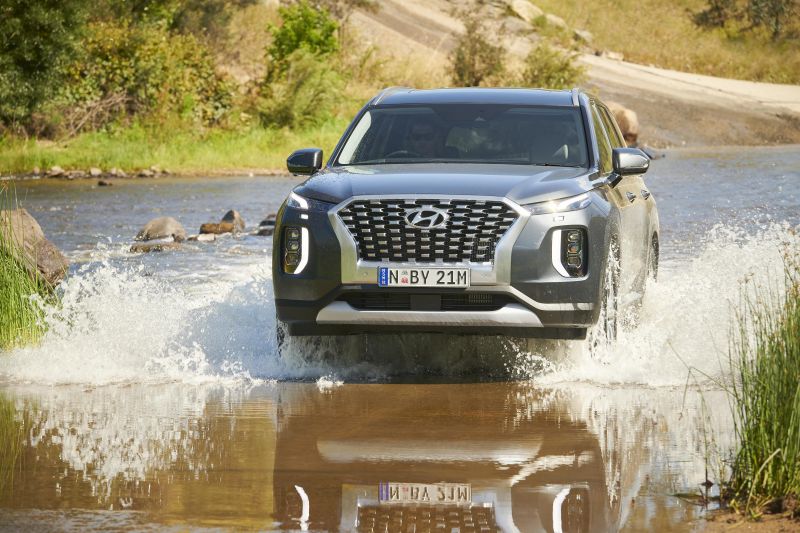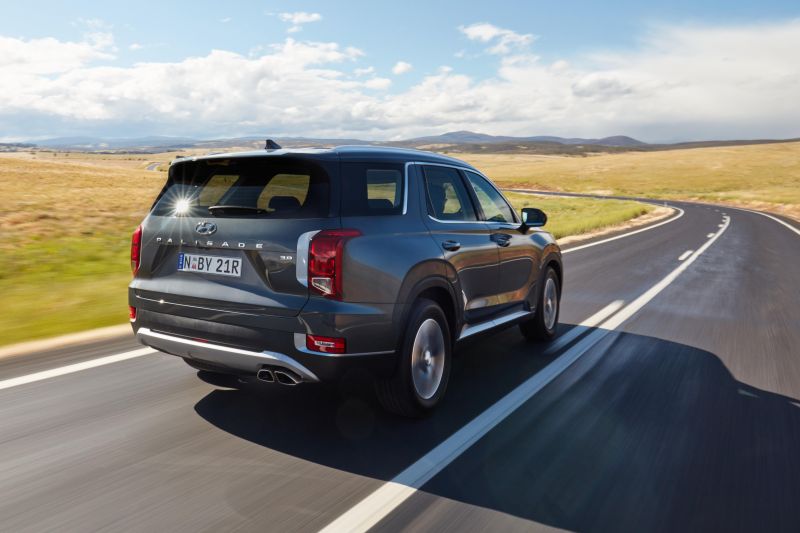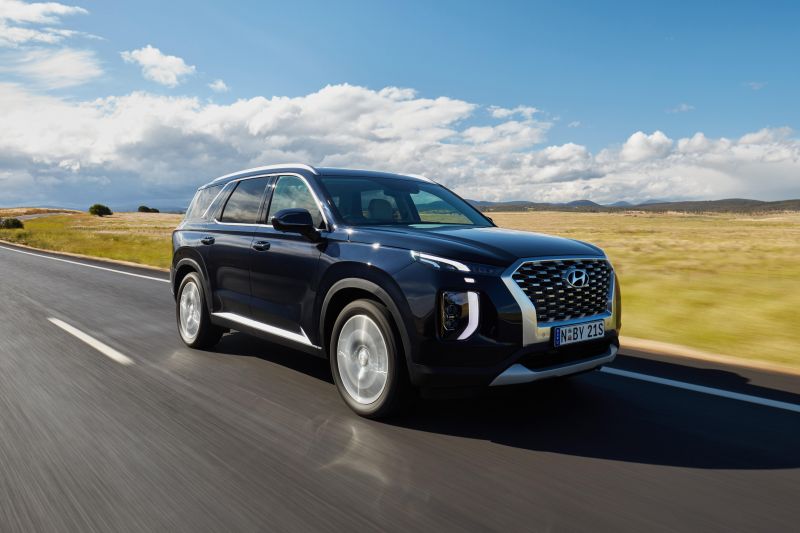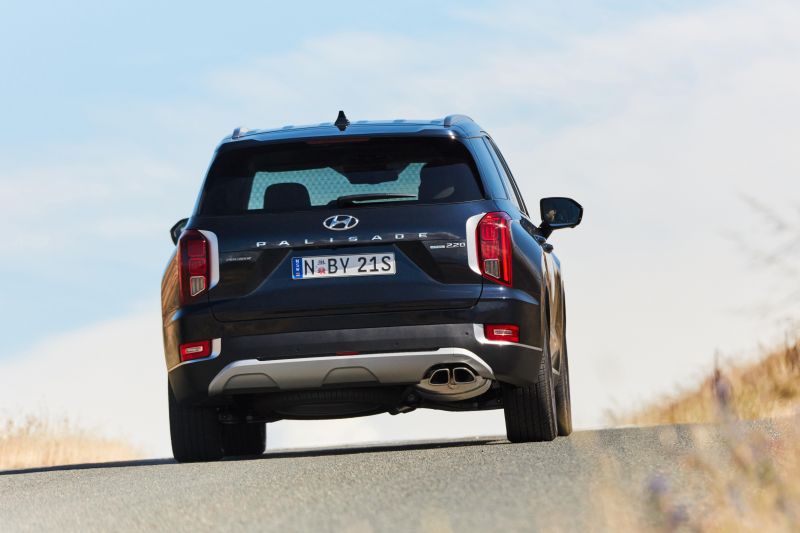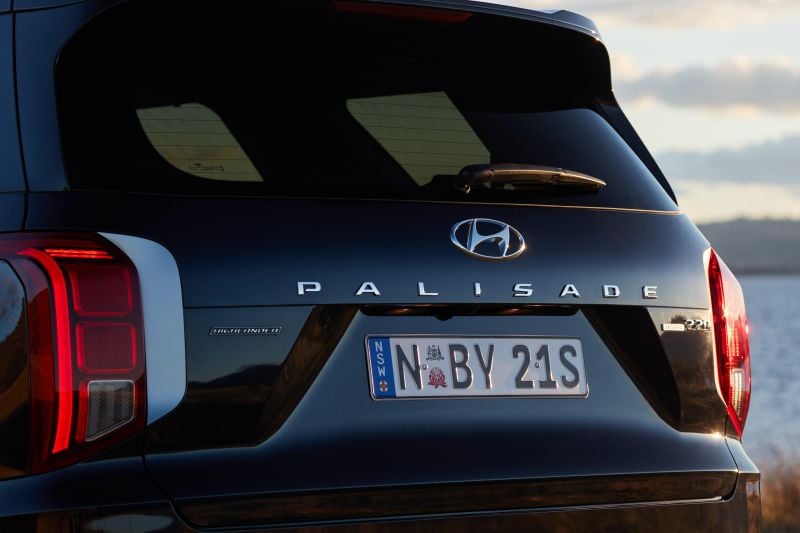Meet the biggest, baddest Hyundai ever. The Palisade is a big brother to the Santa Fe with more space on the inside and more presence on the outside, Hyundai’s take on a bold and brash family hauler like the BMW X7 or Mercedes-Benz GLS.
It’s sold alongside its Kia twin, the Telluride, in North America – but in Australia, it’s essentially a party of one.
Not only does it provide an eight-seat alternative to Hyundai’s own Santa Fe, it’s tasked with stealing sales away from petrol-powered family haulers such as the Mazda CX-9 and Nissan Pathfinder, along with diesel body-on-frame off-roaders like the Toyota Prado.
Although it won’t be topping the sales charts for Hyundai, it’s not expected to be a slow-selling niche buster either. Australia is the first right-hand drive country to get its hands on the car, and the only one capable of achieving meaningful sales volume in the Hyundai world.
A quick glance at the spec sheet is all you need to know Hyundai is casting its net wide with the Palisade. Along with diesel and petrol engine options, there’s seven- and eight-seat interiors, and two well-specced trim levels to choose from.
Does this bold family hauler have the substance to match its considerable swagger?

How much does the Hyundai Palisade cost?
Pricing for the Palisade kicks off at $60,000 before on-road costs for the base petrol front-wheel drive model, simply badged Palisade. Opting for a turbo-diesel engine with all-wheel drive bumps the sticker price to $65,000 before on-roads.
The range-topping Palisade Highlander starts $71,000 before on-road costs with the petrol engine, and stretches to $75,000 before on-roads with the turbo-diesel engine.
At the bottom end of the range, the Palisade undercuts range-topping versions of the smaller Santa Fe in petrol ($2700) and diesel ($200) guises.
It’s less expensive than the front-wheel drive Mazda CX-9 GT and Azami, and slots between the front-drive Nissan Pathfinder ST-L N-Trek and Pathfinder Ti on price.
The entry petrol model also bisects the two range-topping Toyota Kluger front-wheel drive options, although an all-new model is on track to arrive in 2021. It’s expected to command a price premium over the current model.
Finding road-focused rivals to the Palisade diesel is difficult, as most large diesel four-wheel drives are body-on-frame off-roaders such as the Toyota Prado (between $59,840 and $87,030 before on-roads) and Ford Everest (between $50,090 and $73,190 before on-roads).
What do you get?
Even the base Palisade has a supersized list of standard inclusions to match its supersized exterior.
Outside, it rides on 18-inch alloy wheels and features a full spread of chrome and aluminium-effect trim pieces – even the base model has presence. LED daytime running lights pair with halogen headlights, and the mirrors are power-folding units.
Keyless entry and push-button start are standard, and the seats are trimmed in black leather. The driver’s seat is powered, the rear-view mirror is auto-dimming, and the cabin features a whopping 16 cupholders and seven USB ports regardless of which model you select.
All three rows of seats get their own air vents, and there are three climate control zones: two in the front, one for the rear.
The driver is faced with analogue instruments and a 7.0-inch trip computer display, along with a 10.25-inch infotainment touchscreen with Android Auto, Apple CarPlay, and factory satellite navigation. A 12-speaker sound system is standard.
Regardless of trim, buyers can choose between seven- and eight-seat configurations for the interior. The former replaces the second-row bench with two plush captain’s chairs, the latter has a regular three-seat bench in both the second and third rows.
Moving to the Highlander gets you plenty of extra equipment to justify the extra $10,000 spend. It rides on larger 20-inch alloy wheels and gets bi-LED headlights on the outside, and gains a powered tailgate.
The cabin features Nappa leather seat trims in beige or burgundy, a head-up display, memory for the driver’s seat, and a dual sunroof.
The front seats and second-row captain’s chairs in seven-seat cars are heated and ventilated, the steering wheel is heated, and the headliner is finished in suede.
Unusually, there are no fold-down roof ‘Jesus’ handles in the front of either Palisade variant.
Is the Hyundai Palisade safe?
Aimed primarily at the Korean and North American markets, the Palisade doesn’t have a Euro NCAP or ANCAP crash rating.
Hyundai Australia has said it won’t be volunteering the Palisade for testing, so it will remain unrated in Australia unless ANCAP buys a car to crash test, or it goes on sale in Europe and is crashed by Euro NCAP.
Moving to the range-topping Palisade Highlander brings a blind-spot view monitor, allowing owners to see a camera feed of their blind-spot in the instrument binnacle.
The American Insurance Institute for Highway Safety (IIHS) awarded the Palisade a Top Safety Pick rating in 2020, with the Hyundai SUV scoring top marks across almost all criteria bar the base model’s headlights and the ease-of-use for child seat anchor points.
Standard safety equipment atop the standard six airbags in Australia will include:
- Autonomous emergency braking
- Driver attention monitoring
- Lane-keeping assist
- Lane-following assist
- Blind-spot monitoring and assist
- Rear cross-traffic alert and assist
- Adaptive cruise control with stop/go
- High-beam assist
- Rear occupant alert
- Safe Exit Assist
- Trailer Stability Assist
- Tyre pressure monitoring
- Front and rear parking sensors
- Reversing camera
Hyundai also points out the curtain airbag in the Palisade covers the d-pillar, so third-row occupants are protected.
What is the Hyundai Palisade like on the inside?
Big and comfortable. At 4980mm long, 1975mm wide and 1750mm tall, with a 2900mm wheelbase, the Palisade is 295mm longer and 76mm wider than the Santa Fe, previously the largest SUV in the Hyundai stable.
Where some carmakers work with Recaro to develop bucket seats for their sports cars, it feels like Hyundai has teamed up with La-Z-Boy to develop the vast, comfortable front seats.
They’re perfect for whittling away hours on the road, especially in the Highlander where they’re heated and cooled. Combined with the broad, raised centre console and tablet-style infotainment display, they make the front of the Palisade feel a bit like mission control.
Unlike the smaller Santa Fe, the Palisade isn’t available locally with Hyundai and Kia’s latest 12.3-inch digital instrument binnacle, but the 7.0-inch display between the dials is still easy to read, rich with information, and capable of displaying a camera feed of what’s in your blind spot when the indicators are activated.
Infotainment comes courtesy of the latest, greatest 10.25-inch infotainment system in the Hyundai world. With wired smartphone mirroring and factory satellite navigation, it’s loaded with everything you’ll need – but functions hidden in the top left-hand corner of the screen can feel like a bit of a stretch, even if you have long arms.
Thankfully, Hyundai has seen fit to provide a proper volume knob and shortcut buttons on the centre console, and there’s a button to access Siri or Google Assistant on the steering wheel when you’re using smartphone mirroring.
Storage spaces are abundant throughout the cabin. There’s a giant space beneath the transmission tunnel with a USB plug and 12V socket, an open bin on the tunnel itself with cupholders, space for keys and wallets, and a wireless phone charger.
All told there are seven USB ports and 16 cupholders in the cabin, enough to keep the whole cabin charged and hydrated on long trips. There’s also a neat function allowing the driver to broadcast to the rear seats like an airline captain, in case people in the back row are having trouble hearing… or if the kids are trying hard to ignore what mum and dad have to say.
The second row is huge, as you’d expect. Variants with the three-row bench have enough legroom and headroom to comfortably house six-foot-seven me behind tall drivers, even though the bench is raised stadium-style to improve visibility (and hopefully reduce carsickness) for shorter passengers.
With roof-mounted vents, a fold-down central armrest, USB ports in the front seat backs, and dual cupholders in the doors, there’s very little wrong with the eight-seat Palisade. But the seven-seat interior is where the action really lies, although it’s expected to attract just 30 per cent of sales.
Not only are the captain’s chairs plush, with heating and cooling in the Highlander, removing the middle seat makes it easier to reach the back row.
With the ability to house five top-tether child seats and three ISOFIX points, the seven-seat layout also allows owners to fit child seats to the second-row seats and access the third row without seat folding, sliding, or wrestling.
Speaking of which, the third row definitely has more space than that of the Santa Fe, although it’s still better for children than adults. Access is easy in seven- and eight-seat variants, thanks to the electrically-folding seatbacks and sliding bases that move a handy 220mm.
There isn’t much wrong with it. The materials in the base model feel high quality – although the Nappa leather trim in the Highlander is a step up, and the beige/pale wood trim looks neat – and the amount of space on offer is top notch.
The logic of making the drive mode selector so prominent on the transmission tunnel is questionable, however, given most owners are unlikely to ever bother with anything other than the standard “Smart” setting, and missing out on the latest tech from the Santa Fe will annoy some. Realistically though, they’re small gripes.
Boot space is 311L with all three rows of seating in place, and 711L with the third row folded.
What’s under the bonnet?
The base engine in the Palisade is a 3.8-litre naturally-aspirated petrol V6 with 217kW of power and 355Nm of torque, mated to an eight-speed automatic transmission and front-wheel drive.
Although all-wheel drive is available with the petrol overseas, Hyundai says it’s not compatible with right-hand drive. It drinks 91RON petrol, and claimed fuel economy is 10.7L/100km.
The more expensive option is a 2.2-litre four-cylinder turbo-diesel with 147kW of power and 440Nm of torque, mated with an eight-speed automatic and all-wheel drive.
If those figures sound familiar, it’s because the engine is shared with the pre-update Santa Fe. Claimed fuel economy is 7.3L/100km on the combined cycle.
Hyundai says the latest version of the 2.2-litre engine and dual-clutch transmission featured in the latest Santa Fe isn’t currently available in the Palisade, but didn’t rule out bringing it as part of an update.
Braked towing capacity is 2200kg, down on the 2500kg on offer from the Santa Fe.
How does the Hyundai Palisade drive?
Hyundai has clearly focused on making the Palisade a big, comfortable place to eat up highway kilometres.
Our launch drive took us from Sydney to Canberra on major highways, country backroads, and gravel tracks, and the big Palisade soaked it all up.
Both the Palisade and Palisade Highlander do an impressive job keeping their big bodies in check, and the bigger wheels on the more expensive model don’t seem to undermine ride quality on rough, patchy back roads.
There’s no big-car float over crests, although the suspension can be a bit noisy when confronted with potholes and sharper lumps and bumps.
Hyundai Australia didn’t fiddle with the factory suspension tune on the Palisade like it does on some other models, but it feels completely at home on local roads.
Clearly keen to show it’s comfortable with whatever Australia can throw at it, Hyundai even threw in a healthy serving of pitted gravel roads.
With limited time behind the wheel in the city it’s hard to gauge how the Palisade will take on the school run, but its light steering and strong all-around visibility should make it easy to thread through tighter streets than our wide-open test route.
Of the two engines, the turbo-diesel is definitely the pick. For one, it’s all-wheel drive. But beyond that, it has more torque than the petrol engine, and doesn’t need to work as hard to shift the near-two-tonne Palisade.
Lean on the throttle and it picks up more readily, and the eight-speed transmission doesn’t need to shuffle down the gears when the driver demands more performance. It’s also impressively refined.
Although there’s a slightly gruff diesel rumble when you really lean on it, it’s a silent partner at highway speeds. Both engines are very quiet and the front of the cabin is impressively hushed at 110km/h, although the rear can get a little bit noisy on coarse-chip surfaces.
As for the petrol? It needs to be pushed a bit harder than the diesel, even though it’s around 100kg lighter. It’s also thirstier, and when you lean on the throttle at highway speeds it needs to drop one, two, three gears before it really gets moving.
That’s not ideal if you’re overtaking with a load of kids on board. It’s no surprise Hyundai Australia expects the diesel to account for 65 per cent of sales.
A typically Hyundai quirk detracts from what’s otherwise a well-sorted family hauler. The lane-centring system is far too grabby, and tries to impart its will on the driver when it’s really not necessary.
Unlike the rest of Hyundai’s new products, the button to turn it off is hidden next to the parking brake by the driver’s right knee. It also needs to be switched off whenever you hop into the car.
How much does the Hyundai Palisade cost to run?
The Palisade will be covered by Hyundai Australia’s five-year, unlimited-kilometre new vehicle warranty with roadside assistance for the same period and lifetime capped-price servicing.
Maintenance is required every 12 months or 15,000km. The first five services in the 3.8-litre petrol Palisade will each cost $399, while the 2.2-litre diesel is more expensive at $469 per service.
CarExpert’s take on the Hyundai Palisade
The Palisade does exactly what you’d expect of it.
It’s bigger than the Santa Fe inside, especially in the second and third rows, and feels more like a people mover than an SUV with the captain’s chairs specced.
It also eats up the highway miles, with a well-sorted suspension tune that’s typical of Hyundai in Australia. We’ll need to spend a bit more time in town with the car to fully explore how it handles the daily grind, but initial impressions are positive.
The turbo-diesel might be more expensive, but it’s the smarter pick of the available engines unless you’re allergic to the black fuel bowser. Not only does it feature all-wheel drive, it’s the stronger engine on the open road, and should be more efficient to boot.
Does the Palisade have the substance to back up its swagger? It certainly looks like it.
A head-to-head with the Mazda CX-9 and Nissan Pathfinder beckons.
Click the images for the full gallery
MORE: Hyundai Palisade news and reviews
MORE: Hyundai news and reviews





